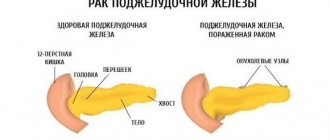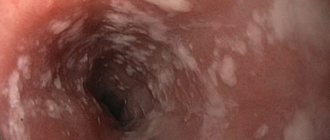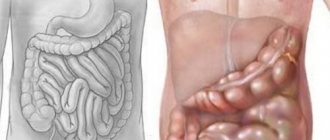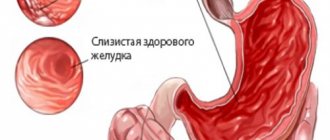What is pancreatic lipomatosis
The pancreas is small in size, weighing only 100 grams. But it is one of the main digestive organs, consisting of two parts. Moreover, the parts are different not only in shape, but also in their functions: one produces enzymes (lipids, amylase, protease), which are involved in the digestion of food in the intestines, and the second produces various hormones, including insulin, which is responsible for reducing blood glucose levels.
It turns out to be a kind of mini-factory that is important for the body, capable of digesting up to 10 kg of various foods per day. And now imagine that for some reason the work of this small enterprise has gone wrong... How will the body react?
Where healthy pancreatic cells die like weeds, adipose tissue will begin to grow, transforming into lipomas or so-called wen. With a nodular form of the disease, they will be single; with a diffuse and mixed course of the disease, they will resemble piled-up islands.
Of course, this will not go unnoticed. As a result of a decrease in the production of necessary enzymes and hormones, metabolism is disrupted, digestion is impaired, and the patient’s condition worsens.
Disturbances in the functioning of the pancreas occur for various reasons. However, the most common are organ injuries with tissue rupture and hematoma formation, obesity, smoking, excessive doses of alcohol, frequent infections, inflammation, stagnation of bile in the gland ducts, previous pancreatitis, liver damage...
Another close relationship is genetic. It has been noticed that if there were relatives in the family who were susceptible to attack by wen, the likelihood of developing lipomatosis will be much higher.
Unfortunately, lipomatosis is an irreversible process. That is, it can be contained, softened, but there is no turning back. In this case, there can be only one consolation - dystrophic changes, as a rule, have no connection with oncology.
The mildest degree of the disease is the first. With it, fat cells are single, which does not affect the functioning of the pancreas or the well-being of the patient. Most often, he learns about his disease by chance, when he undergoes an examination, for example, an echography of the abdominal organs.
The second degree is much more serious. Here, lipomas replace 30 to 60 percent of the total volume of the organ, which, naturally, cannot but affect the pancreas. Due to a decrease in the production of enzymes, the patient begins to have serious digestive problems: dyspepsia, bloating, flatulence, nausea (especially after eating), belching with an unpleasant odor, abdominal pain...
Troubles, as they say, intensify when the third degree of the disease is noted: overcoming the “threshold” of 60 percent, when wen, like raiders, captures more than two | third of the organ. As the disease progresses, endocrine disorders join dyspeptic symptoms.
Abdominal pain becomes constant, diarrhea becomes more frequent, which can alternate with constipation, vomiting often occurs, appetite increases, the feeling of thirst increases... As adipose tissue grows, it compresses the organ and nearby tissues, which leads to poor circulation. With a deficiency of insulin, diabetes mellitus develops.
However, before moving on to treatment, it is necessary to make a correct diagnosis, and for this it is necessary to take tests and undergo examinations.
Symptoms
Typically, patients consult a doctor at stages 2 or 3 of the pathology. After all, very often it occurs without obvious symptoms. The pancreas has very large compensatory capabilities, so if only part of its tissue is affected, it continues to work normally. But gradually the volume of adipose tissue increases. This most often leads to a decrease in the production of enzymes necessary for digestion, and inflammatory processes may also appear due to compression of the ducts or blood vessels.
Therefore, manifestations of lipomatosis most often develop according to the type of other gastrointestinal pathologies. The absence of specific symptoms does not allow the disease to be diagnosed in time. The patient may notice the following signs:
- heaviness in the upper abdomen after eating;
- pain in the left hypochondrium or in the epigastric region;
- nausea, vomiting;
- bowel dysfunction;
- flatulence, bloating;
- loss of appetite;
- weakness, decreased performance.
Abdominal discomfort and indigestion occur when fatty tissue occupies more than half the area of the pancreas
Degree of development of lipomatosis
Pancreatic lipomatosis is divided into degrees:
- First degree of fatty degeneration. Adipose tissue has replaced up to 30% of the gland. Symptoms have not yet appeared; pathology can be detected by chance during an ultrasound.
- Second degree. Fat cells have replaced 30-60% of the mass of the pancreas. Flatulence, belching, and other dyspeptic symptoms may occur. This indicates a dysfunction of the pancreas, a lack of enzymes for digestion.
- Third degree. Pathological cells over 60%. Possible vomiting, diarrhea, flatulence. Insulin production is impaired, and symptoms of diabetes are possible:
- dry skin;
- constant thirst appears;
- urine output increases;
- weight gain due to excessive appetite.
Other symptoms may also appear:
- increased gas formation;
- pain on the left under the rib;
- bloating;
- change in stool;
- general malaise;
- inclusion of fat in stool.
The pancreas secretes pancreatic juice. It has great enzymatic power, which helps in the digestion of essential substances.
When it enters the intestines along with bile and intestinal juice, the juice continues the digestion that was started by saliva and gastric juice.
It contains the necessary enzymes:
- amylase, which converts starch into sugar;
- trypsin and chymotrypsin - break down protein;
- lipase – breaks down fats;
- renin
The intrasecretory function of the gland is associated with the production of insulin and glucagon. If, due to lipomatosis or other disorders, the pancreas produces insufficient insulin, its deficiency will occur in the body, which can lead to diabetes mellitus.
Forms of the disease
The proliferation of adipose tissue can be regional or generalized. There are several variants of the disease:
- Knotty. This form is characterized by single lipomas in the subcutaneous tissue area.
- Diffuse. In this form, multiple lipomatous nodes are distributed without any sequence. The lesion has no clear boundaries, which complicates the diagnosis of the pathology. Lipomas grow quickly. This form is characteristic of the pancreas.
- Mixed.
Causes
There is no consensus on the causes of pancreatic lipomatosis. Possible factors influencing the formation of pathology:
- metabolism is disrupted, an imbalance of certain hormones occurs;
- with damage to the liver, thyroid gland, pituitary gland;
- infectious lesion of the pancreas;
- malignant tumor of the respiratory system;
- alcoholism;
- diabetes;
- genetic factor;
- the presence of lipomatous foci in other organs;
- advanced age;
- excess weight.
The mechanism of degeneration of gland cells is a protective reaction that is activated to preserve the integrity of the organ.
Lipomatosis is an irreversible process. With its development, the pancreas works less and less fully.
The pancreas produces enzymes and hormones. Any violation can lead to tangible consequences for the entire body.
Changes in the pancreas like lipomatosis occur for various reasons. Among them:
- genetic predisposition (medicine knows cases of hereditary or familial lipomatosis);
- acute or chronic inflammatory damage to the pancreas;
- diabetes mellitus and other endocrine pathologies;
- excess weight;
- pathologies associated with metabolic disorders;
- bad habits (especially alcohol abuse);
- fatty hepatosis and other liver diseases.
More often, lipomatosis develops after an active inflammatory process in the pancreas. Partial damage to organ cells causes their replacement with adipose tissue - one of the types of regenerative process aimed at maintaining homeostasis. Pancreatic fibrolipomatosis (replacement of cells with adipose and connective tissue) is a common consequence of pancreatic necrosis.
Classification
Depending on the prevalence of the pathological process, three degrees of fatty degeneration are distinguished:
- pancreatic lipomatosis degree 1 is characterized by replacement with adipose tissue up to ⅓ of the volume of the organ;
- fatty degeneration of the 2nd degree indicates damage to half of all pancreatic cells;
- grade 3 pathology is a sign of fatty infiltration of most of the organ.
Depending on the form of the lesion, there are:
- diffuse lipomatosis – the presence of widespread small fat deposits;
- island, or nodular lipomatosis, in which the accumulation of adipose tissue forms limited foci;
- mixed lipomatosis - combines manifestations of both forms.
Treatment
Treatment of glandular lipomatosis is carried out conservatively or surgically. If the tumor does not exceed 3 cm in size, it is treated conservatively. Otherwise, they resort to surgical intervention. In many cases, Diprospan
, a drug that is injected directly into a patient's pancreatic tumor.
Important! Regarding surgical tactics for treating lipomatosis, laser exposure or endoscopy of the gland is used. However, such treatment does not always provide complete recovery, since small lipomas remain after the operation. Under unfavorable factors, they can be activated and lead to irreversible consequences in the gland.
To relieve unpleasant symptoms, the patient is prescribed:
- painkillers for the gland - No-shpa
,
Ibuprofen
,
Nemesil
,
Advil, Solpaflex; - improve the digestive process Pancreatin
,
Creon
,
Penzital
,
Mezim
; - antiemetic drugs - Reglan
,
Emetizan
,
Nauzifar
; - to restore stool, Imodium
,
Enterol
,
Loperamide
.
Diagnosis of fatty degeneration of the pancreas
The key procedure in diagnosing the disease is ultrasound of the pancreas. After identifying any changes in it, a biopsy is performed - inserting a thin needle through the skin into the lipoma and collecting tissue for histological analysis.
A blood test - general and biochemical - will help identify the inflammatory process in the body, determine the levels of cholesterol, hormones, and pancreatic enzymes. A stool test will indicate the presence of undigested fats.
Treatment of pancreatic lipomatosis (if it is not an advanced third stage, when excision of dystrophic foci is performed) comes down to relieving inflammation, restraining the growth of fat cells, while maintaining the lumen of the ducts, and preserving the ability of the gland to participate in the digestive process.
To compensate for the deficiency of pancreatic enzymes, to facilitate the digestion of heavy foods rich in proteins, fats, carbohydrates, drugs containing pancreatin are needed: pancreatin, mezim, mezim-forte (take 2 tablets 3 times a day), Creon (10-25 thousand each . ED 3 times a day).
ED is the dosage of enzymes, they vary from 10 thousand to 35 thousand units, and are prescribed depending on the degree of their deficiency in the body.
To relieve spasms and pain that are localized mainly in the upper abdomen, you cannot do without antispasmodics. These include no-spa, papaverine, baralgin (1 tablet 2-3 times a day), duspatalin (1 capsule 2 times a day).
Sometimes patients ask whether they can take other painkillers instead, for example, analgin or diclofenac. I answer: “No, it’s impossible, especially with an “acute” abdomen.” For the treatment of abdominal pain (of course, in combination with other medications), antispasmodics are considered first-line drugs.
By relaxing smooth muscles, they improve blood supply to the walls of the organ, and the pain goes away on its own.
As a rule, treatment with antispasmodics is short-term - no more than 3-5 days. If the pain persists, further treatment must be agreed with the attending physician.
To suppress the aggressive environment of hydrochloric acid in the stomach, antacids are prescribed - Omez, Pariet, Nexium, rabeprazole (20 mg in the morning on an empty stomach for 4 weeks), Almagel (15-30 mg 3 times a day for 2 weeks), Maalox ( 1 sachet 3 times a day for 2 weeks); for diarrhea - loperamide (1-2 capsules 3 times a day for 2-3 days); to reduce intestinal spasms - mebeverine (100 mg 3-4 times a day); for nausea, vomiting - cerucal, domperidone (20 mg 2-3 times a day).
The examination of a patient with suspected pancreatic lipomatosis is based on:
- collecting complaints and medical history;
- general examination, superficial and deep palpation of the abdomen;
- laboratory tests: UAC, OAM;
- biochemical analysis (determination of blood sugar, pancreatic amylase, ALT and AST transaminases, direct and indirect bilirubin);
- scatological research;
- Ultrasound - allows you to identify abnormalities in the structure of the pancreas, as well as its increased echogenicity;
Lipomatosis develops slowly, so the process can be stopped if detected in the early stages. Treatment is based on the principles of a healthy lifestyle, nutritional correction, and elimination of risk factors. Additionally, measures are taken to normalize digestion and replenish the lack of hormones.
In addition to traditional methods of treatment, you can use folk remedies. The possibility of using certain medicinal herbs must be agreed with your doctor in order to exclude possible side effects.
It is useful to take wormwood during the development of fatty degeneration. You need to grind the dry grass to a powder state. Before each meal, take a pinch of wormwood powder with warm boiled water.
In case of exacerbation of the disease, it is recommended to use an infusion of immortelle and chamomile. You need to drink this infusion 100 ml before meals 3 times a day. Take 1 tbsp. l. each herb, mix and brew 250 ml of boiling water. Cool, then filter.
An effective remedy is birch bud tincture. A glass of buds must be filled with vodka to completely cover the raw material. Leave in a dark place for a month, shaking the medicine periodically. Take the prepared tincture three times a day, 1 tbsp. l.
Helps in the treatment of fatty degeneration. You need to grind the root or herb of the plant, brew 1 tbsp. l. raw materials 250 ml of boiling water, let it brew. Drink 100-120 ml 2-3 times a day.
An infusion of plantain leaves prevents the spread of lipomatosis. You need to brew 1 tbsp. l. pre-crushed leaves 250 ml of boiling water, strain after 2 hours. You should drink the infusion 3 times a day before meals, 70-80 ml.
The growth of fatty lesions can be slowed down by taking an infusion of lilac buds. Need 1 tbsp. l. pour 250 ml of boiling water over the raw material and leave to steep for 30 minutes. The finished infusion should be filtered, take 1 tbsp. l. before meals three times a day.
Mix calendula, nettle, valerian and St. John's wort, taken in equal parts. Pour 1 tbsp. l. herbal mixture 200 ml of boiling water, wait until it cools and strain the medicine. You should drink this infusion in small portions throughout the day.
For pancreatic lipomatosis, you need not only to use folk remedies, but also to eat right. You should eat in small portions up to 4-5 times a day. Exclude fried, spicy, fatty, salty and smoked foods, and meat broths from the diet. Pumpkin, zucchini and Jerusalem artichoke are useful. It is recommended to use herbal infusions instead of tea.
Sample menu for lipomatosis
An approximate menu for a week for pancreatic lipomatosis will allow you to create your own diet based on the list of foods and dishes desired for consumption. Combined with drug treatment.
- Breakfast – liquid semolina milk porridge.
- Lunch – buckwheat soup with vegetable broth, liquid puree, steamed rabbit meatballs.
- Dinner – steamed omelette.
- Breakfast – low-fat cottage cheese.
- Lunch – mashed wheat soup with broth, vegetable puree with cod.
- Dinner – rice porridge with chicken fillet.
- Breakfast – steamed omelet.
- Lunch – chicken broth with grated vegetables, porridge with steamed lean meat cutlets.
- Dinner – beetroot or potato puree with boiled low-fat fish.
- Breakfast – diluted milk semolina.
- Lunch – pureed vegetable soup, durum wheat noodles with steamed meatballs.
- Dinner – oatmeal with fish cutlets.
- Breakfast – rice milk porridge.
- Lunch – viscous soup of vegetables and rice, boiled vegetables with rabbit meat.
- Dinner – steamed chicken soufflé.
- Breakfast – liquid oatmeal porridge.
- Lunch – soup with vegetables, meat casserole, boiled vegetables.
- Dinner – light porridge with steamed fish cutlets.
- Breakfast – soft-boiled egg.
- Lunch – rice soup with low-fat meat broth, vegetable puree with meatballs.
- Dinner – durum wheat pasta without oil, vegetable stew.
To create the right diet, you should consult your doctor or nutritionist.
Main clinical manifestations
For a long time, there are no clinical signs of the disease. Lipomatosis often develops over decades, but is diagnosed only when the functional activity of the pancreas noticeably decreases.
The first symptoms of moderate pancreas fatty degeneration include:
- poor tolerance to meat, eggs, dairy products and other protein foods;
- frequent attacks of nausea in the morning or after eating;
- feeling of bloating, distension in the intestines;
- problems with stool: alternating constipation and diarrhea;
- frequent urge to defecate;
- foul-smelling stool with pieces of undigested food, which is difficult to wash off due to the high fat content.
As pancreatic insufficiency progresses, the following pathologies may appear:
- impaired glucose tolerance and non-insulin-dependent diabetes mellitus;
- carbohydrate metabolism disorders;
- other endocrine disorders.
Compression of the pancreas by overgrown fatty tissue is characterized by dull pain in the epigastrium (middle part of the abdomen), flatulence, and vomiting.
Etiology of the disease
The main reason for the appearance of the pathological process has not been established as of 2020, however, there are unfavorable factors that significantly increase the risk of developing lipomatosis. These factors include:
- Inflammatory processes affecting pancreatic tissue (pancreatitis);
- Chronic diseases of the digestive system;
- Systematic drinking of alcohol;
- Compounded heredity (if the person’s closest relatives had similar problems);
- Pathologies of an endocrine nature (for example, diabetes mellitus);
- Chronic liver damage (hepatitis in one form or another);
- Hormonal imbalance (in particular, low levels of thyroid hormones).
Expert opinion
Shoshorin Yuri
General practitioner, site expert
These factors do not always lead to the development of lipomatosis. So, if a person has these problems, he does not always develop the disease. On the contrary, even in the absence of these reasons, fatty degeneration of the pancreas (lipomatosis) can develop.
Diet for lipid metabolism disorders
Along with drug treatment, diet is also extremely important. First, you need to understand which foods should be considered friends of the pancreas, and which ones should be classified as enemies. It is necessary to exclude all sour fruits from the diet: plums, pears, peaches, cherry plums, oranges, lemons.
Apples (if they are sweet) can be baked in the oven and eaten pureed. As for vegetables, you should avoid radishes, radishes, and white cabbage; it is undesirable to use sorrel and rhubarb. It is better to eat cucumbers without peeling, and bake tomatoes, like sweet apples, in the oven.
Alcohol and “heavy” foods—pork, lard, fatty fish, smoked meats, spicy, salty foods, canned food, fast foods—can “kill” the damaged pancreas. Cakes, pastries, freshly baked bread, coffee, lemonades, strong brewed tea, sausages, fatty cheeses, sour cream are also classified as “difficult to digest”, and therefore harmful.
Among the “friends” should be considered low-fat cottage cheese, lean white meat (turkey, chicken, rabbit), pureed soups (preferably with weak meat broth or vegetable broth), mucous, porridge cooked in water with the addition of butter, boiled vegetables, white croutons or oven-dried bread.
Healthy drinks include jelly, dried fruit compote, green tea, rosehip decoction, and still mineral water.
There is a lot of controversy about milk: should you drink it or not? I will say this: if the body does not rebel after taking it, does not respond with diarrhea, pain, or unpleasant belching, then this is your product. If, on the contrary, you should pay attention to the percentage of fat content of the milk and, if necessary, reduce it or abandon it altogether.
Other important rules in nutrition - you need to eat little, but often - 5-6 times a day; monitor the temperature of the food you eat, adhering to the well-known principle “Food should not be too hot and not too cold”; chew it well; Arrange fasting days at least once every 7-10 days.
Diet
Diet is an important stage in the treatment of lipomatosis and other problems with the pancreas. To prevent the growth of fat and improve overall well-being, you must follow diet No. 5. You need to eat often and in small portions, eating about 5 times a day.
Remove from menu:
- sweets;
- smoked meats;
- alcohol;
- pickles;
- fried, spicy or fatty foods;
- any nuts;
- chips;
- sweet sodas.
It is recommended to cook food only by steaming. For garnish you should prefer:
- zucchini;
- baked pumpkin;
- Brussels sprouts;
- vegetable salads.
It is also recommended to include in the menu:
- dairy products;
- porridge from buckwheat, oats, millet;
- lean fish.
Herbal medicine for fatty degeneration
Typically, diagnostic measures do not take much time, so a gastroenterologist begins to treat lipomatosis immediately after its detection. The main goal of therapy is to prevent the growth of new fat cells and reduce the size of already formed pathological foci. This is achieved through lifestyle correction, a specialized diet, and taking medications. Treatment with folk remedies has been successfully used as a complex therapy.
Lifestyle recommendations for patients with pancreatic lipomatosis include:
- Reducing stress in life. It is important to be less nervous about trifles and, if possible, to avoid nervous shocks.
- Get adequate sleep at least 7-8 hours daily.
- Strict adherence to the daily routine, as well as a balanced alternation of work, active and passive rest.
- Complete cessation of bad habits.
- Refusal of intense physical activity.
- Hiking, exercise therapy and breathing exercises.
Medical nutrition
Nutrition plays an important role in the treatment of the disease. The diet for pancreatic lipomatosis is based on the following principles:
- Fractional meals (up to 6-7 times a day) in small portions.
- The preferred cooking option is steaming without adding fat.
- Exclusion from the diet of fatty, fried and spicy foods, sweets.
- Limiting the daily energy value of dishes to 2800-3000 kcal.
Patients with lipomatosis need to include in the menu more often:
- low-fat varieties of fish, meat, poultry;
- milk (fat content no more than 2.5%) and dairy products;
- cereals – buckwheat, oatmeal, rice.
A significant spread of fatty degeneration is an indication for the use of medications. All medications prescribed by a specialist are aimed at reducing the intensity of the manifestations of the pathology.
The medications of choice are:
- NSAIDs (Nurofen, Ibuprofen);
- enzyme preparations (Creon, Mezim);
- detoxification agents (Nauzifar, Reglan);
- drugs that normalize intestinal motility (Loperamide, Imodium).
In rare cases, when growths of adipose tissue compress neighboring organs, the issue of surgical treatment of the disease is decided.
Fatty pancreas is a common disease that has negative health consequences. Its prognosis largely depends on the stage at which it was diagnosed. By regularly undergoing preventive examinations and following medical recommendations, you can prevent its development and avoid serious health problems.
Prevention
To avoid such disorders in the gland, it is important to follow preventive measures. Standard events look like this:
- timely treatment of chronic and acute ailments of the gastrointestinal tract, as well as internal secretion;
- nutrition balanced for the pancreas;
- healthy lifestyle - eliminate bad habits and abuse, frequent rich meals, provide moderate physical activity, comfortable rest;
- prevention of physical harm and mental trauma.
Traditional recipes for treating the pancreas
In the fight against growing adipose tissue, as well as other manifestations of the disease - inflammation, pain, diarrhea, flatulence, medicinal plants also have a good effect. They are also able (albeit partially) to restore the lost secretory functions of the pancreas and strengthen the immune system.
An infusion of oats is considered a good remedy for fat deposits in the pancreas. For this, 1 tbsp. Place a spoonful of beans crushed in a coffee grinder in a thermos in the evening and pour 2 cups of boiling water. In the morning, after straining, take 100 ml 3 times a day. The course is 1-2 months.
In addition, an infusion of oats (it is rightfully considered the elixir of longevity) cleanses the body of toxins, reduces blood sugar and cholesterol, and is able to regenerate damaged tissues.
And here is an anti-inflammatory collection. It consists of peppermint herb, St. John's wort, stinging nettle, calendula flowers, crushed and taken in equal parts. To prepare the infusion, take 2 tbsp. spoons of the mixture, pour 2 cups of boiling water, leave for 1 hour. After straining, take 100 ml 3 times a day for 3-4 weeks.
If lipomatosis is accompanied by diarrhea, this recipe will help: mix bird cherry fruits, oak bark and blueberry leaves in equal parts. 2 tbsp. Place spoons of the mixture in a thermos and pour 2 cups of boiling water, leave overnight. After straining, take half a glass 3-4 times a day. The course is 1-2 weeks, and if necessary - a month.
Pomegranate decoction also has good fixing properties. To prepare it, pour 30 g of dry pomegranate peels with 1 glass of hot water, keep on low heat for 15 minutes, leave for an hour. Take 2-3 tbsp. spoons 3-4 times a day an hour before meals.
For constipation, take powder from dried dandelion roots: 0.5 teaspoon 3 times a day before meals or 10 mustard seeds.
Provoking factors
The provocateurs of changes occurring in the pancreas and causing lipomatosis have not yet been identified. Although experts say that when a lipoma developing in the pancreas begins to appear in other internal organs, then the risk of its increase directly in the primary organ increases significantly, several times. Indirect provocateurs of lipomatosis are:
- alcohol or nicotine addiction;
- DM types 1 and 2;
- obesity of the pancreas without treatment of the problem;
- hepatitis and hypothyroidism;
- Pancreatitis is a pathology of the pancreas in the chronic stage.
Стоит отведать хоть раз таких цыпочек, они встречаются с интеллигентными, порядочными мужчинами, проверенные феи проститутки Орска, фото настоящие, не типажные. Если вам необходима шикарная спутница для какого-либо важного мероприятия или события. Милые проверенные феи проститутки Орска, сладкие и ухоженные, они такие игривые и раскрепощённые, что у тебя будет сегодня классный секс. Выбери девушку сейчас.









